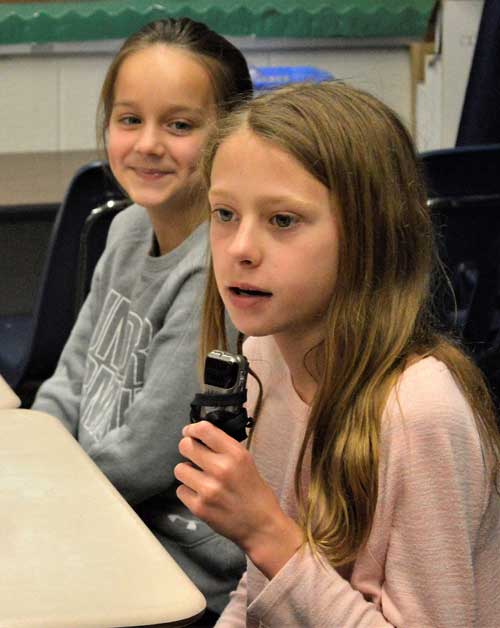The question before Jaylin Riley was this: What does the phrase “down in the dumps” mean in two different sentences – one about a bulldozer covering up trash, and one about a girl’s best friend moving to another school?
“One is literal, where the words mean what they say, and one is nonliteral, where the words have a different meaning,” teacher Char Hartley said to Jaylin, who was standing at her teacher’s desk while her third-grade classmates listened.
| More Student, Less Teacher
The basic elements of Gradual Release of Responsibility:
Source: Kenowa Hills Public Schools; Douglas Fisher and Nancy Frey, “Better Learning through Structured Teaching” |
Jaylin correctly picked the friend moving away as nonliteral, meaning “she was really, really sad because it was her best friend.”
Their “collaborative conversation” demonstrated how to analyze literal vs. nonliteral language, part of a purposeful progression of increasingly independent exercises for the class.
Soon they were talking in small groups about other nonliteral phrases, such as Grandma’s spaghetti is hands-down the best I ever have tasted.
“OK, what do you guys think this means?” Kadayshia Black asked her three desk mates. “I have no idea what this means.”
It’s all part of Gradual Release of Responsibility, an instruction method designed to gradually turn over more work on learning from the teacher to the student. In Hartley’s classroom, every lesson, every day, has a goal, and the students work together to understand it.
“They analyze themselves and each other,” said Hartley, a Central Elementary teacher in her 27th year at Kenowa Hills. “It’s not coming from me telling them. It needs to come from the kids telling the kids. My whole goal is to have them take more control and responsibility.”
System-wide Shift
That’s the crux of a teaching paradigm Kenowa has adopted system-wide over the past three years, as part of its move to gear teaching to individual student mastery of subject matter rather than uniform time on task. Within this larger goal of “personal mastery,” Gradual Release of Responsibility (GRR) aims to develop “competent, independent learners,” said Michael Burde, Kenowa assistant superintendent.

“I like to think of Personal Mastery as the heart of our beliefs and philosophies of what education should look like,” Burde said by email. “GRR is a vehicle or framework to help us systematically get us to this vision for education.”
For Hartley, it’s a method that works. She is a veteran of several teaching assignments, including teaching students with developmental disabilities in Kenowa, severely impaired students in Chicago, and as a speech and language pathologist in Caledonia. Hartley says GRR makes sense and that a lot of teachers were using elements of it even before Kenowa provided training.
The four main components – focused instruction, guided instruction, collaborative learning and independent learning – provide a flexible framework that teachers can dive into as needed, Hartley said: “The beauty of it is it could be used for any lesson, any time.”
While it’s important she capture students’ attention in her focus lesson – the “I do it” phase on what they’re going to learn and why – the collaborative learning discussions among students are key, she says. To ensure all students’ voices are heard, each adds his or her color to a tower of connected cubes when they contribute an idea.
“They have to listen to each other and ask each other questions and try to go deeper,” Hartley said. “A lot of adults could learn from these kids.”

Leadership = Classroom Jobs
Her classroom walls are covered with evidence of student responsibilities: the class vision, signed by all of them (“We will learn as much as we can every day, so that we can get a great education …”); reminders to show respect and have self-control; student-written inspirations (“Keep trying even if it’s hard”); the social goal of the day (“I can have collaborative learning conversations where all voices are heard …”).
We did mention this is third grade, right?
“They need to know why they’re here at school,” Hartley explained. “It’s absolutely important they know the goal and that they’re going to achieve that in different ways.”
Ownership of learning extends to leadership. Students take on various jobs, such as “procedure starters,” who keep studies on time, and “shine-o-meters,” who track how students’ comments link together using building blocks.
Hartley has one microphone, students another, which they pass around during their whole-group discussions. At the beginning of one class, Dominic Bierema took the mic to announce that day’s academic goal: “The task is to identify examples of nonliteral language and identify their meanings.”

Hartley gave them one example of something she asked her son: Cat got your tongue? Kadayshia Black ventured its meaning: “Something happened to him and he didn’t want to talk about it.”
Later, as students discussed other examples in small groups, Olivia Pasikowski said she likes working with classmates because “you have other topics to bounce off with your partner.” If she doesn’t get a math problem by herself, she said, she can ask another student or, if absolutely necessary, the teacher.
As to what she likes most, Olivia said, “Everybody’s nice in class, and nobody bullies.”
CONNECT















